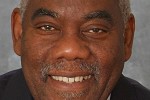By Dr. Selwyn R. Cudjoe
September 10, 2017
 In “Independence Legacies,” Gerard Besson offers his reading of Trinidad’s modern history. He says: “From 1783, Europeans and Black people who were not enslaved… arrived mostly from French islands. Many were refugees, political enemies and strangers to each other.… After the British conquest of 1797 to this milieu were added Chinese, Portuguese, and African freedmen. Then after much miscegenation, some decades later, Indian indentureship commenced, and latterly [sic] the Lebanese and Syrians arrived” (my emphasis).
In “Independence Legacies,” Gerard Besson offers his reading of Trinidad’s modern history. He says: “From 1783, Europeans and Black people who were not enslaved… arrived mostly from French islands. Many were refugees, political enemies and strangers to each other.… After the British conquest of 1797 to this milieu were added Chinese, Portuguese, and African freedmen. Then after much miscegenation, some decades later, Indian indentureship commenced, and latterly [sic] the Lebanese and Syrians arrived” (my emphasis).
When the British arrived in 1797 there were 17,643 people in the island of which 10,009 were enslaved Africans, 1,082 free people of color, 2,086 whites, and approximately 1,000 Amerindians. In 1803 there were 19,464 enslaved Africans, 5,275 free people of color, 2,261 whites and a similar number of Amerindians. In 1813 there were 25, 457 enslaved people, which was reduced to 24,037 by 1818.
By 1824 cruelty and hard work reduced the enslaved African population to 23,110 people. There were 15,000 free blacks and persons of color and 4,096 whites. In other words, 38,110 of Trinidad’s population of 42,000 people were black and colored people.
By 1844, 59,815 people lived in the island. The “General Return of the Population of the Island of Trinidad,” the first official census, showed there were 936 natives of Britain and Ireland,33, 128 natives of Trinidad,12,106 natives of the British colonies, 869 natives of Foreign Europe,7,287 natives of Africa, and 1,869 people who Martin Sorzano, Surveyor General, described as “Others” (The Anti-Slavery Reporter, October 16, 1844).
Besson collapses this predominantly African population into a “miscegenetic” framework, jumps to the 20th century, translates diversity into divisions, and concludes: “The divisions that shaped our colonial experience have continued to blight our post-independence existence. This is so because of the politics of independence, which did not take sufficient consideration of the assimilation of the Indian-descended population that had been in Trinidad for over 100 years…. It was not taken to heart by the shapers of the independence movement, who were Creole people of a generation born in the 1910s.”
Besson misses that Trinidadians (that is, primarily black people) began to fight for independence immediately after apprenticeship ended in 1838. On April 29, 1849, St. Luce Philip, the first black man to become a member of the Legislative Council, chaired a large public meeting in Port of Spain that petitioned the British government to grant the colony the right to form a Legislative Council “elected by the people, in lieu of the present form of government” (Trinidadian, April 20, 1849).
Henry Fitt, another official member of the Legislative Council, argued that the inhabitants should control their own affairs. He bemoaned that the Legislative Council consisted “exclusively of gentlemen nominated by the Crown, and a majority of its members were subservient to Government influence by virtue of their official appointment. The Government may, whenever it so pleased, command a majority of votes, and thus render any opposition on the part of the non-official members” (Trinidadian, April 20, 1849).
In 1889, those who came to a massive meeting at the Queen’s Park Savannah clamored for constitutional reform. Further constitution changes took place in 1925 when the first local people were elected to the Legislative Council. The first general election on the basis of universal adult suffrage took place in 1946. It was based on “the Dominion Election Act 1936 (Canada) but retain[ed] a few provisions of the old ordinance [of 1934]” (Report of the Legislative General Election 1946). It would have been helpful if Besson had examined the political developments between 1844 and 1946 before he alighted on the “shapers of the Independence movement,” the bêtes noire of his contempt.
The successful candidates of the 1946 elections were Albert Gomes, Roy Joseph, Chanka Maraj, Clarence Carmichael Abidh, Ramjit Kumar, Timothy Rodal, Victor Bryan, and A. P. T. James. Their racial composition was as follows: 4 Indians, 2 off white (using Besson’s description), 2 blacks, and one Portuguese.
These results, according to John La Guerre, “demonstrated the political power of East Indians in the political arena.” Therefore, it is inaccurate to suggest that the Indo-Trinbagonians were treated as “transients who had outstayed their welcome and would somehow return to India.”
These considerations lead ineluctably to Besson’s fallacy that Afro-Creole politicians, “the shapers of the independence movement, Creole people of a generation born in the 1910s [he really means black people]… did not take sufficient consideration of the assimilation of the Indian-descended population.”
Besson does not tell us how they were supposed to cater to the “assimilation of the Indian-descended population.” Didn’t Dr. Rudranath Capildeo represent that segment of the population at the Marlborough House Conference?
As to the “blight factor,” I draw upon Howard Schultz, executive chairman of Starbucks, who responded to Donald Trump’s narrow-minded chauvinism and veiled racism: “People from many lands and with diverse backgrounds and lifestyles…are a source of much unmatched strength in the global economy and a digitally connected world” (Financial Times, September 1, 2017).
One wonders if Besson, in his desire to malign black people and our Independence leaders, took his script from Trump, a man who has an abiding hatred of non-white people.
Next week I will conclude my examination of Besson’s article.
